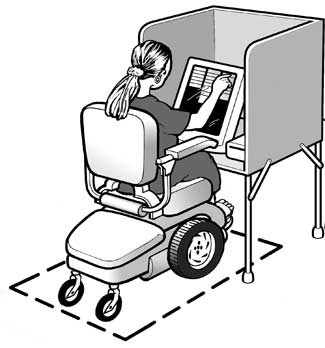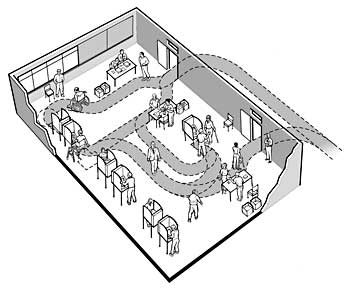Voting Areas
Problem
Voting often occurs in a small room or area within a building, with little space at the check-in tables and voting machines, making it difficult for voters with mobility disabilities to move through the voting area and cast their ballots. In winter months or during the rainy season, election officials may use cardboard, plastic floor coverings, tarps, or mats to cover the floor. These coverings can make it difficult to navigate and can easily become trip hazards for voters with disabilities and others.
ADA Requirements
There must be a minimum 36 inch wide route in and through the voting area. There also must be enough clear floor space in at least one voting station or booth to allow a voter using a wheelchair or other mobility device to approach, maneuver, and leave the voting station. Floor surfaces must be stable, firm, and slip resistant.
Temporary Solutions
Arrange check-in tables and voting stations to provide an accessible path for the voter to go from the check-in table to the voting station and out again. At least one voting station should provide at least 30 x 48 inches of clear floor space to allow a voter using a wheelchair or other mobility device to maneuver. All floor coverings, such as cardboard or plastic sheets, should be removed or firmly affixed to the floor to provide a stable and slip-resistant floor.

An accessible voting station with clear floor space

Overhead view of the polling place showing
the accessible route and maneuvering spaces
for voters who use mobility devices
Voting Access: Where to Start
To provide temporary access to voters with disabilities, election officials should always keep in mind the accessible route into and through the polling place. Understanding how all voters arrive at the polls, park or drop people off, move through the facility and the voting area, and back out again will help identify physical barriers that will need to be remediated. Using the tools discussed in this document can provide temporary access and will ensure that voters with disabilities can fully participate in the election process.
Voting Access: Some Useful Resources
This document provides guidance on providing temporary access to polling places. Election officials should note that the ADA requires jurisdictions to select polling sites that are accessible or can be made accessible for elections. The ADA title II regulation and the ADA Standards for Accessible Design set out what makes a facility accessible and should be used to determine the level of accessibility at each facility being used or considered for use as a polling place. Election officials should consult the Justice Department’s ADA Checklist for Polling Places for more detailed guidance on how to assess whether a polling place is fully accessible to voters with disabilities or if barriers can be removed.
The Checklist, title II regulation, and the ADA Standards are available at http://www.ada.gov/.
In addition, election officials should consult the Department’s 7-page publication on the rights of voters with disabilities, The Americans with Disabilities Act and Other Federal Laws Protecting the Rights of Voters with Disabilities, also available at http://www.ada.gov/.

User Comments/Questions
Add Comment/Question